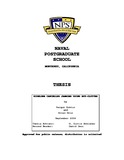Stochastic Acoustic Ray Tracing Eighth Dynamically Orthogonal Equations
| dc.contributor.advisor | Lermusiaux, Pierre | |
| dc.contributor.author | Humara, Michael Jesus | |
| dc.date | May 2020 | |
| dc.date.accessioned | 2020-09-11T23:59:13Z | |
| dc.date.available | 2020-09-11T23:59:13Z | |
| dc.date.issued | 2020-05 | |
| dc.identifier.uri | https://hdl.handle.net/10945/65727 | |
| dc.description | CIVINS (Civilian Institutions) Thesis document | en_US |
| dc.description.abstract | Developing accurate and computationally efficient models for ocean acoustics is inherently challenging due to several factors including the complex physical processes and the need to provide results on a large range of scales. Furthermore, the ocean itself is an inherently dynamic environment within the multiple scales. Even if we could measure the exact properties at a specific instant, the ocean will continue to change in the smallest temporal scales, ever increasing the uncertainty in the ocean prediction. In this work, we explore ocean acoustic prediction from the basics of the wave equation and its derivation. We then explain the deterministic implementations of the Parabolic Equation, Ray Theory, and Level Sets methods for ocean acoustic computation. We investigate methods for evolving stochastic fields using direct Monte Carlo, Empirical Orthogonal Functions, and adaptive Dynamically Orthogonal (DO) differential equations. As we evaluate the potential of Reduced-Order Models for stochastic ocean acoustics prediction, for the first time, we derive and implement the stochastic DO differential equations for Ray Tracing (DO-Ray), starting from the differential equations of Ray theory. With a stochastic DO-Ray implementation, we can start from non-Gaussian environmental uncertainties and compute the stochastic acoustic ray fields in a reduced order fashion, all while preserving the complex statistics of the ocean environment and the nonlinear relations with stochastic ray tracing. We outline a deterministic Ray-Tracing model, validate our implementation, and perform Monte Carlo stochastic computation as a basis for comparison. We then present the stochastic DO-Ray methodology with detailed derivations. We develop varied algorithms and discuss implementation challenges and solutions, using again direct Monte Carlo for comparison. We apply the stochastic DO-Ray methodology to three idealized cases of stochastic sound-speed profiles (SSPs): constant-gradients, uncertain deep-sound channel, and a varied sonic layer depth. Through this implementation with non-Gaussian examples, we observe the ability to represent the stochastic ray trace field in a reduced order fashion. | en_US |
| dc.description.sponsorship | CIVINS | en_US |
| dc.description.sponsorship | MIT-WHOI | en_US |
| dc.format.extent | 127 p. | en_US |
| dc.language.iso | en_US | |
| dc.publisher | Monterey California. Naval Postgraduate School | en_US |
| dc.title | Stochastic Acoustic Ray Tracing Eighth Dynamically Orthogonal Equations | en_US |
| dc.type | Thesis | en_US |
| dc.contributor.corporate | Cambridge, Massachusetts : Massachusetts Institute of Technology (MIT) | |
| dc.subject.author | Stochastic Process | en_US |
| dc.subject.author | Acoustic Wave Propagation | en_US |
| dc.subject.author | Ray Tracing | en_US |
| dc.description.funder | CIVINS | en_US |
| dc.description.funder | CIVINS | en_US |
| dc.description.funder | MIT-WHOI | en_US |
| etd.thesisdegree.name | Master of Science, Mechanical Engineering | en_US |
| etd.thesisdegree.level | Masters | en_US |
| etd.thesisdegree.grantor | Cambridge, Massachusetts : Massachusetts Institute of Technology (MIT) | en_US |
| dc.description.distributionstatement | Approved for public release; distribution is unlimited. |
Files in this item
This item appears in the following Collection(s)
-
1. Thesis and Dissertation Collection, all items
Publicly releasable NPS Theses, Dissertations, MBA Professional Reports, Joint Applied Projects, Systems Engineering Project Reports and other NPS degree-earning written works. -
3. CIVINS (Civilian Institutions) Theses and Dissertations





